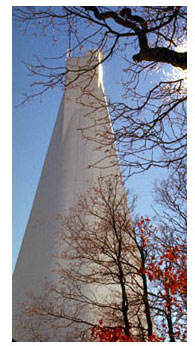SUNSPOT, N.M., Oct. 12 -- A memorial service will be held on Friday to pay tribute to Richard B. Dunn, a pioneering solar physicist who developed advanced optical solar telescopes and whose work led to new adaptive optics technologies to compensate for atmospheric blurring in solar observing. Dunn, astronomer emeritus at the National Solar Observatory, died of a heart attack at the age of 77 on Sept. 28 in Las  Cruces, N.M.; the memorial will be held at the Sunspot visitor center at 10:30 a.m.
Cruces, N.M.; the memorial will be held at the Sunspot visitor center at 10:30 a.m.
Dunn began his career at Sacramento Peak in 1953 while a graduate student pursuing his doctorate at Harvard University, and stayed at the observatory until his retirement in 1998. Dunn was the third director of what was then the US Air Force's Sacramento Peak Observatory at Sunspot. Sac Peak became a major component of the National Science Foundation's (NSF) National Solar Observatory (NSO) in the 1980s. Dunn lived in Las Cruces and continued to work part-time at Sunspot until 2003.
Dunn's landmark contribution was the design and development of the 356-ft.-tall Vacuum Tower Telescope (VTT). When put into service in October 1969 by the Air Force, the VTT revolutionized the capabilities of solar telescopes. The innovative design employs a vertical vacuum tube (more than half of it underground) with its instrument platform attached so it rotates with the telescope tube as it tracks the sun during the day. By evacuating the telescope and by careful control of its environment at the telescope entrance, Dunn eliminated many image deterioration effects. His vacuum telescope concept has been used in several major solar telescopes constructed since then; the VTT was renamed the Richard B. Dunn Solar Telescope by NSF in his honor in 1998. 
The Richard B. Dunn Solar Telescope (formerly the Vacuum Tower Telescope) is the largest of the solar research instruments atop Sacramento Peak, N.M. The telescope uses a light path through a tube evacuated of air to produce highly resolved solar images. The tower portion rises 13 stories (136 ft, or 41.5 m) above ground level. Its innovative design 36 years ago by its namesake revolutionized the capabilities of solar telescopes. (Photo: NOAO/AURA/NSF)
Dunn's colleagues in the field say much of our current knowledge of the solar atmosphere, including its magnetic field structure, solar flares, prominences and the solar corona, resulted from his work. Solar astronomers worldwide called on his expertise in designing their telescopes and he was involved in the design of far more solar telescopes than anyone else.
"Dunn's career was, in large part, aimed at obtaining solar observations of the highest possible spatial resolution," said Jack Zirker, a past director at Sac Peak. "Only by studying the small magnetic structures near the surface, he thought, could we hope to understand the powerful solar flares that periodically disturb the Earth. His instruments were, for the most part, designed for this purpose and he was proven correct in the end. Most recently he pioneered the development of special electronic equipment for sharpening solar images. Dunn was recognized as one of the foremost experimental solar physicists of his generation. He was responsible for the design and construction of many of the telescopes and instruments that made the SPO one of the premier solar observatories in the world. His work was admired and copied over the world."
"Dick played a major role in the advancement of our understanding of the sun and its impacts on Earth and on space weather," recalled Stephen L. Keil, current NSO director. "His work from 1952 to 1976 as an Air Force employee was instrumental in making the facility at Sacramento Peak into the world's outstanding solar observatory. When the NSF took over Sac Peak and eventually made it a major component of the National Solar Observatory, Dick first led and then continued to play a vital role in its telescope and instrument programs."
For more information on Dunn, his telescope and the NSO, visit: www.nso.edu